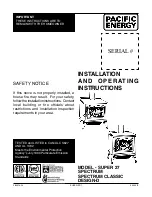
GENERAL GUIDELINES
Please refer specifically to current
building regulations which apply to your
country or region (see page 13). Adopt
whichever provides the highest / safest
margin.
The Hearth
The hearth should be
made of solid non-combustible
material, set on a firm and level base
and should be at least 125mm (5”)
thick. This can include the thickness of
any non-combustible floor under the
hearth or non-combustible decorative
surface. It must be capable of
supporting the weight of the stove
(when loaded) along with any attached
flue pipes which bear down on the
stove. This hearth must conform to
local building regulations which may
vary from country to country.
In England and Wales there is a
minimum requirement for the hearth
to project 500mm (20”) in front of any
brick or stone recess and 150mm (6”)
at each side of the recess. For a
free-standing stove the minimum
hearth size should be 840mm by
840mm (2’10” by 2’10” approx) and
should provide the minimum clearances
for the stove which are outlined in this
handbook. The hearth should extend
by a minimum of 225mm (9”) from
the front of the stove (which includes
the edge of the ash lip). As a general
rule it is best to extend the hearth to at
least 75mm (3”) beyond the furthest
out-swing of the stove door to avoid
any potential live ash held on the door
falling on to combustible flooring or
floor coverings. If the top of the hearth
and any combustible floor coverings are
27
level with each other then a retaining
fender should be fitted to warn
occupants of the hearth area.
Alternatively, a 28mm (1.1”) change in
level provided by a decorative non-
combustible material such as stone,
marble, granite, ceramic tiles etc could
be used.
Please note that some materials, such
as marble, may not be suitable when
used as a single sheet and will need to
be pieced together to allow for
expansion from the heat of the stove.
Your stove dealer or installer should be
able to advise you about this.
The ‘Fireplace’
The stove can be sited
within a brick or stone fireplace recess
or used free-standing. The fireplace side
and rear walls should be at least 75mm
thick and made of non-combustible
brick or stone. In a fireplace setting you
should allow a minimum distance of
100mm (4”) from the back of the stove
and 150mm (6”) at either side with at
least 300mm (12”) from the top of the
stove. Ideally, the overall height of the
fireplace aperture should be at least
1200mm (4’) high.
Providing adequate air space around
the stove will allow the stove to
radiate heat and circulate warm air
around the room. It will also prevent
structural damage to the walls and
potentially damaging over-heating of
the stove. If it is not possible to
maintain these spaces they could be
reduced to 100mm (4”) at the sides but
only if this can be compensated with
twice the equivalent air space at the
top of the stove and the non-
















































